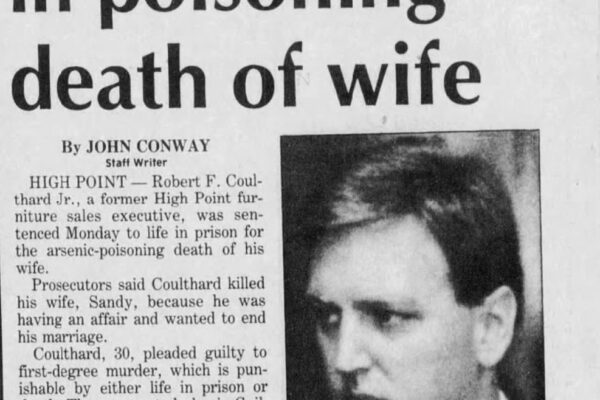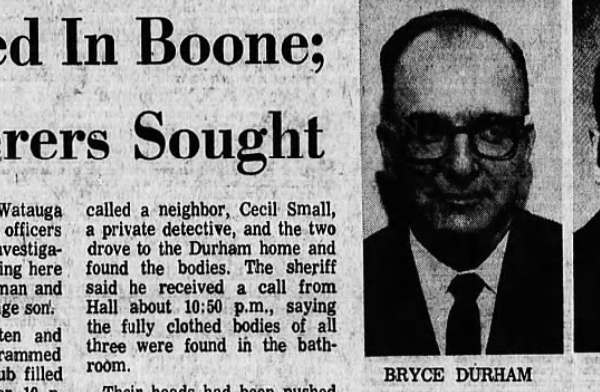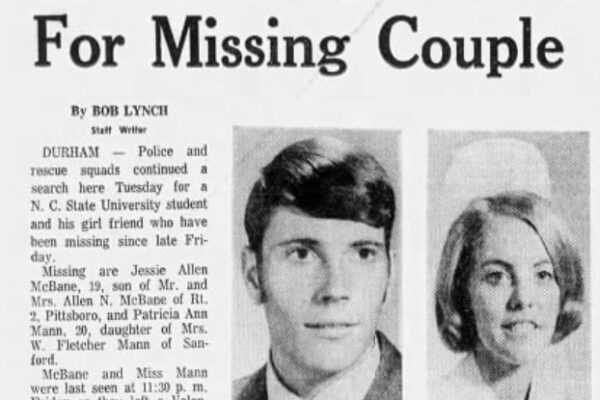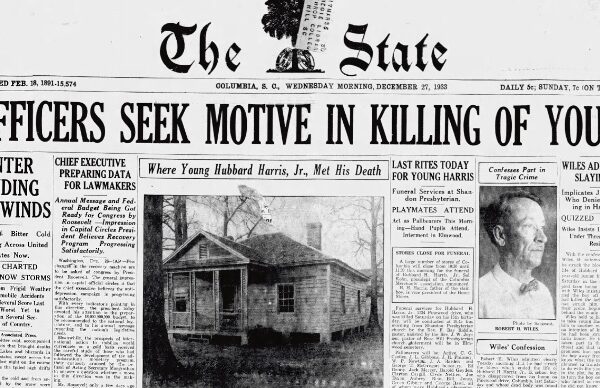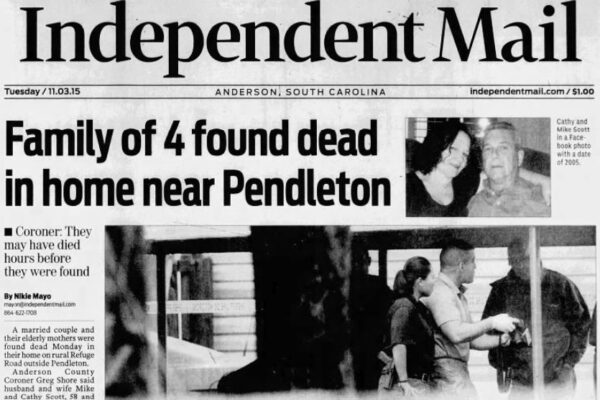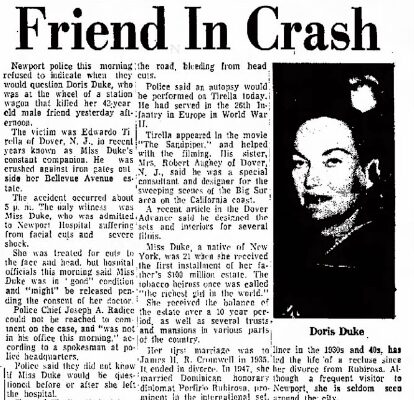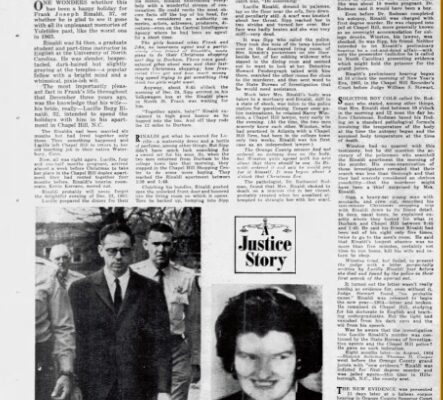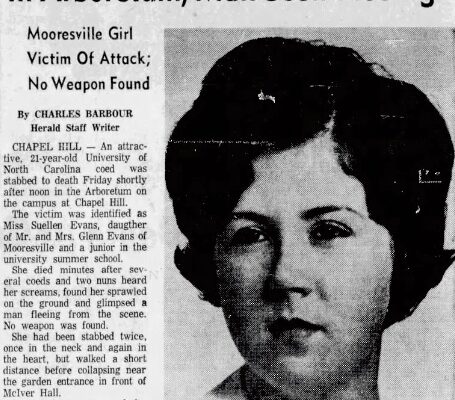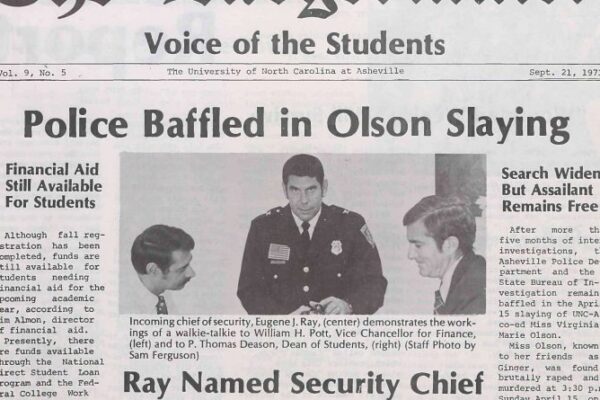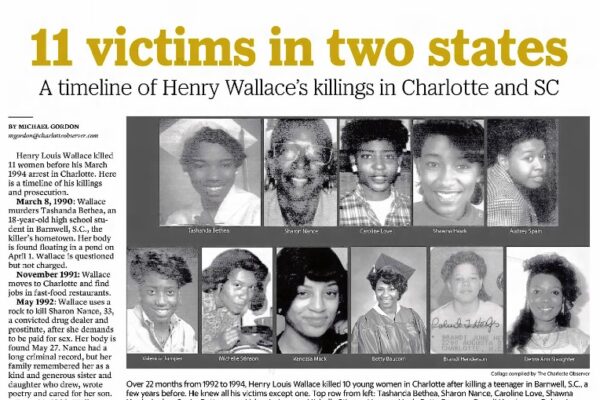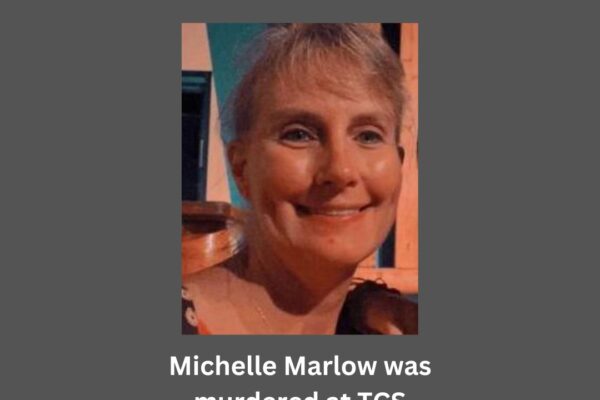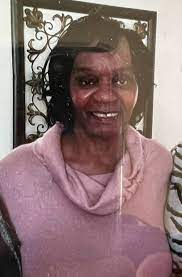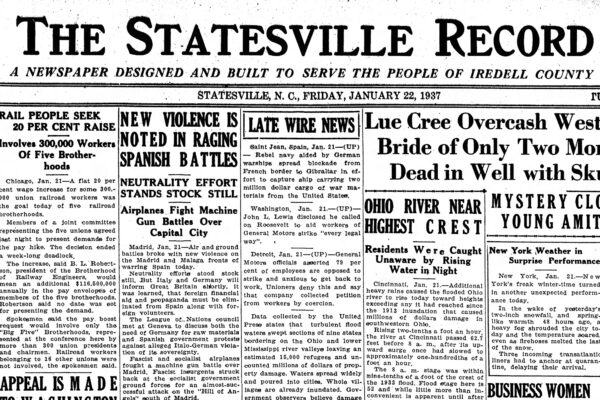On July 9, 1988, 30-year-old High Point, North Carolina resident Sandra Coulthard passed away at Duke University Medical Center. She’d been sick for about six months with vomiting, diarrhea, vomiting, and numbness of her feet and fingers. Doctors had diagnosed her with Guillain-Barre (Ghee-yan Bah-ray) syndrome and had been treating her for it, but her symptoms never improved.
Guillain-Barre syndrome is a rare neurological disorder that causes a person’s immune system to attack their nervous system. It often begins suddenly and as symptoms increase, can cause weakness and paralysis. While there is no cure for Guillain-Barre, treatments such as plasma exchange and intravenous immunoglobulin therapy can be administered for relief of symptoms.
Sandy, a married mother with two small children, first went to High Point Regional Hospital in early June of 1988 before being transferred to Duke University Medical Center. Sandy was a member of the High Point Junior League and Emerywood Baptist Church. She and her husband Robert Franklin Coulthard, Jr. had both met at Wake Forest University in Winston-Salem and had been married since 1982.
When the results of Sandy’s autopsy came back from the state medical examiner’s office, they showed she had died from arsenic poisoning. Dr. John Butts, the chief state medical examiner, said, “It was our feeling that she had had more than one dose of arsenic.”
Investigators arranged to have Sandy’s body exhumed after the autopsy results were released so they could remove hair samples. On September 19, 1988, police arrested her husband, 31-year-old Robert Coulthard, and charged him with first-degree murder. Robert was then a vice-president at Crestwood Furniture Company. Guilford District Attorney said that Sandy had received at least one dose of arsenic after she had been admitted to Duke in June of 1988.
After the news of Robert’s arrest was released, neighbors of the couple said they couldn’t believe he’d been involved in his wife’s death. They thought Robert and Sandy were both nice and seemed happy. Within two months of his arrest, the community learned that Robert was indeed guilty of the crime he’d been charged with—he admitted it himself when he pleaded guilty in late November of 1988. Guilford District Attorney Jim Kimel said Sandy Coulthard’s autopsy showed she had 142 times the normal concentration of arsenic found in humans.
Tests conducted on her hair samples showed she had received at least five separate doses, beginning in December 1987. She had likely been given the first dose in fast-food hamburger purchased by Robert. This also meant she had poisoned with arsenic while she was carrying the couple’s second child, a son who was only a year old when she passed away. Their daughter was three at the time.
An Arsenic Delivery
District Attorney Kimel said records showed Robert Coulthard ordered arsenic from a New Jersey chemical company on September 26, 1986. This was five days after he returned from a trip with a woman he was having an affair with. The arsenic was shipped to Robert’s workplace at the time, Hickory Furniture Company in High Point. He used a personal check to pay for the poison. But a co-worker noticed the box displaying a skull and crossbones, and jokingly asked if he planned to kill his wife, to which he replied, “No, we have a rat problem.”
After Sandy became ill in April of 1988, Robert applied for an increase in life insurance benefits for his wife. The request was denied because Sandy was being treated for what doctor’s thought was Guillain-Barre syndrome. When she passed away, the couple had $351,000 in life insurance policies naming Robert and the two children as the beneficiaries.
Assistant District Attorney Richard Lyle said he believed Robert’s motive for murder was that he wanted out of his marriage to Sandy so he could proceed with his other romantic relationship.
The judge in the case ruled that the prosecutors had insufficient evidence of aggravating factors for a jury to consider the death penalty for Robert Coulthard. Those aggravating factors involve a person murdering for financial gain and carrying out a murder that was especially heinous, atrocious, and cruel. Doctors at Duke University Medical Center said Sandy Coulthard didn’t suffer before her death because she was on medication most of the time she was ill. I’m sure Sandy would probably disagree that she wasn’t suffering from the poisoning. Instead, Robert Coulthard received a sentence of life in prison, where he still sits today.
A professor and researcher from Davidson College named Cynthia Lewis discussed the murder of Sandy Coulthard in a journal article she wrote for the Journal of Criminal Justice and Popular Culture titled “Monstrous Arrogance: Husbands Who Choose Murder over Divorce.” She interviewed Mark McNeill, who was a detective on the case when Sandy was murdered. He shared that immediately after Sandy’s death, Robert went to a pay phone in the hospital to call his mistress. He called Robert “an organized psychopath.” Investigators believed Robert had his children listed as the beneficiaries of the couple’s life insurance policies so he couldn’t be accused of profiting off her murder.
They thought he wasn’t just seeking an escape from his wife, but possibly from his whole family. He had become addicted to gambling and enjoyed living a high-roller lifestyle with other women. Investigators theorized he either was going to use the life insurance money as a trust fund for his children, where someone else like Sandy’s parents could raise them, or he could use that money to fund the unencumbered lifestyle he was seeking. His children did indeed go to live with their maternal grandparents after he was sentenced for the murder.
A Wrongful Death Lawsuit
After Sandy’s death, her family filed a wrongful-death lawsuit against High Point Regional Hospital and Duke University Medical Center, claiming physicians failed to act upon blood test results that showed Sandy had high levels of arsenic in her system before she died. They eventually reached an undisclosed settlement with High Point Regional Hospital and two doctors named in the suit, and filed for a voluntary dismissal of the case against Duke University and Private Diagnostic Clinic of Durham and High Point Internal Medicine Associates.
The next murder I want to talk about took place on December 2, 2000. That’s when a 30-year-old Raleigh man named Eric Miller passed away unexpectedly after being admitted to Rex Hospital. Eric was working as a post-doctoral fellow at UNC-chapel Hill’s Lineberger Comprehensive Cancer Center.
According to an article that ran in The News and Observer immediately following his death, Eric first became ill with flu-like symptoms after work on November 15. He was admitted to the hospital that night and was then transferred over to the UNC healthcare system in Chapel Hill. Bloodwork that was taken during that stay indicated he had arsenic in his symptom, but those results weren’t available to him until a week later. On November 24, he was released from the hospital after his condition improved. But on November 30, he became ill again and after being admitted to the hospital, lab tests again revealed arsenic in his blood. Eric told an officer there he had no idea how he would have come into contact with arsenic.
Investigators were immediately suspicious. Following his death, they searched the home Eric shared with his wife, Ann, and their infant daughter. Then, on December 4, they searched for arsenic, or any of its derivatives at GlaxoSmithKline in Research Triangle Park, where Ann worked as a research scientist. Amont the items they confiscated were sodium cacodylate, two expense reports, a fulfillment contract, a lab notebook, and a Hewlett Packard computer and keyboard. Police took 200 milliliters of the sodium cacodylate, which is a toxic arsenic compound, but one that isn’t as dangerous as the most potent form of arsenic.
The News and Observer interviewed an expert on poisons at the time for the article, Dr. Marsha Ford, who worked in Charlotte as the director of the Carolina Poison Center. She said sodium cacodylate is a white crystalline chemical often used as an herbicide and insecticide. Some forms of it are often found in research labs, especially in ones seeking cancer treatments. At the time GlaxoSmithKline had done research on leukemia chemotherapy. A lethal dose of sodium cacodylate would be equivalent to what you’d find in a shot glass. Symptoms of exposure include nausea, vomiting, diarrhea, abdominal pain, low blood pressure, and rapid heart rate. Eric Miller was experiencing many of these symptoms in the weeks before his death.
In mid-January of 2001, the local news outlets began painting a picture of the events that led up to Eric Miller’s suspicious death. They reported that police obtained a search warrant to search the home of a man named Derril Willard, age 37, as part of the investigation. Derrill was a colleague of Ann Miller’s from Glaxo SmithKline and was apparently with Eric the night he first began experiencing signs of illness on November 15. On that night, Eric went bowling with Derril Willard and two other colleagues of Ann’s. Derril bought the group a pitcher of beer and Eric commented about it tasting bad. He continued bowling even after beginning to feel sick about an hour later. When he got home, Ann noticed he was in distress and drove him to Rex Hospital when he was first admitted.
A Secret Relationship
Police were searching Derril Willard’s home because they had discovered he and Ann Miller had been having an affair. Both were married at the time, and both would have had access to the arsenic compounds through their jobs at Glaxo SmithKline. Investigators searched two vehicles at the Willard home, two Compaq Presario computers, and other documents and bills. The search warrants indicated they were looking for evidence of trips, arsenic and other poisons, and any items related to the Millers.
The day after police executed the search warrants, Derril Willard took his own life. His wife discovered his body in their garage when she returned home. He left a note behind that said he had no involvement in Eric’s death. He had consulted an attorney though, named Rick Gammon, and Gammon said he believed the Raleigh police considered Derril a suspect.
Poisoning in an Affluent Community
This story quickly gained a lot of traction because, as one Associated Press headline read, it featured a “Poisoning mystery that unfolded among educated suburbanites in North Carolina.” Writer Estes Thompson wrote, “While arsenic has been the weapon of choice in at least two other infamous North Carolina killings, those didn’t feature the well-educated, professional, young suburbanites who make up the cast of the Miller story.”
Hubert Stone, who served as the sheriff when Velma Barfield was arrested for poisoning four different people with arsenic, said people who used arsenic in cases he investigated typically appeared to be very loving. It was usually someone who was very close to the victim, and not someone anyone would suspect.
By all accounts, Eric and Ann Miller seemed to be a happy couple. That’s why the news of his death, and the involvement of arsenic, was so shocking.
Ann Miller was born Ann Brier and she attended high school in Spring Grove, Pennsylvania. She participated in band, choir, track, cheerleading, and played varsity field hockey. She was nominated for prom queen her senior year. Eric Miller was also active and successful in high school, which was in Indiana, and he played tennis and served as an altar boy at the Catholic church his family attended for eight years. He met Ann in a biology class when both were attending Purdue University. In 1992, they both graduated from the university with honors and degrees in biology and moved to Raleigh to pursue doctoral degrees at N.C. State University. While Eric immersed himself in research at the university, Ann had a harder time finding a good fit. She eventually left her doctorate studies and took a job with GlaxoSmithKline after obtaining a master’s degree in biochemistry.
Colleagues and friends told The News and Observer that Ann was always immaculately dressed, liked having her hair and nails done, and enjoyed home and crafting projects. The couple married in 1993. They joined a local Catholic church, helped organize retreats for engaged couples, and spoke at weekend marriage retreats. Ann was making good money at her research job, and in 1999, after Eric received his doctorate, he began working as an AIDS researcher at UNC-Chapel Hill’s Lineberger Comprehensive Cancer Center. Ann gave birth to their daughter in January of 2000. The couple coordinated their schedules to drop off and pick up their daughter at her day care.
Meanwhile, although just as motivated and ambitious as Eric and Ann Miller, Derril Willard came from a much different background. He grew up in Arkansas, where his father had a job as a supervisor for the state power company. His classmates remembered him as always sitting on the front row, terrified to make a ‘B,’ and ended up finishing first in his class of 180 students. His classmates also voted him “Most Likely to Succeed.” While he was friendly and courteous, he’d also grown up with a strict Baptist upbringing and didn’t party on the weekends like others in town.
He graduated from the University of Arkansas, where he met his future wife, a woman named Yvette. They first moved to Philadelphia, so he could take a job with a pharmaceutical company, then to Research Triangle Park when he accepted a position with GlaxoSmithKline. He and his wife had a young daughter and bought a house in North Raleigh. Somewhere along the way, while working with Ann Miller on an arthritis research project, the two developed a relationship.
Discovery of a Love Triangle
As police were searching through Ann’s work computer after Eric’s death, they found e-mail messages and phone calls between her and Derril. They both retained attorneys quickly, and then Derril shot himself in the family garage the day after he was served with the search warrants. He left behind a three-year-old daughter. His family didn’t believe he had anything to do with Eric’s death from arsenic poisoning, but felt like the media coverage of the case had driven him to suicide. He was ashamed to have the news of his affair revealed for all the world to see.
Those observing from the outside wondered if Ann and Derril had poisoned Eric with arsenic, why would they do it with a substance that could so easily be traced back to them? It didn’t make sense. Ann’s friends from college didn’t believe she could have done something so terrible. Money didn’t seem to be a motive. Eric Miller had a life insurance policy totaling $100,000, but Ann had relinquished control of his estate over to his parents. He didn’t have a will at the time of his death.
In May of 2001, the North Carolina Medical Examiner released Eric’s autopsy report. It confirmed he’d been killed by arsenic, and had received two doses of the deadly poison, one while he was in the hospital. The substance taken from Ann’s laboratory was the same found in Eric’s blood, liver, and urine. It appeared he had also received a dose of arsenic the summer before his death. Phone records showed that Ann and Derril had called each other over 100 times in the fall of 2000. One 24-minute call took place less than two hours before Eric died.
Ann stopped going to work and became fearful of leaving her house due to the intense media coverage. Investigators worked to gather as much evidence as they could so they could have an airtight case against Eric’s widow. It would take almost four years for them to make an arrest. On September 27, 2004, a jury indicted her on first-degree murder charges in Wake County. She was denied bail.
One of the main things preventing investigators from making an arrest was a discussion Derril Willard had with his attorney before his death. When police asked this attorney, Richard Gammon, what Derrill had told him during their meeting, he cited attorney client privilege. Ann Miller had moved out of the Raleigh area to Wilmington, North Carolina and remarried to a Christian rock guitarist. Finally, in the spring of 2004, the North Carolina Supreme Court said Gammon would have to tell a grand jury what he knew about Eric’s death. He complied. Ann, who now went by Ann Kontz, was arrested a few months later.
The Wake County District Attorney chose not to seek the death penalty in Ann Miller Kontz’s murder trial. On December 10, 2004, a Wake County Superior Court Judge set her bail at $3 million dollars after District Attorney Colon Willoughby shared the contents of a private conversation between Derril Willard and his attorney Richard Gammon shortly before his death. He told his lawyer that Ann had admitted to administering poison to Eric Miller before he died. She said that while visiting her husband in the hospital, she took a syringe from her purse and injected the contents into his IV line.
During Ann Miller Kontz’s bail hearing, her attorney argued that she wasn’t a flight risk, had no criminal convictions, and could live with her second husband and parents in Wilmington if the court required it. He presented letters of support from her family and friends testifying about her character. Her father and second husband both said Ann was emotionally and mentally stable and unlikely to flee the area or try and intimidate witnesses. But it was the transcript of the conversation Derrill Willard had with his attorney before his death that made the biggest impact at the bail hearing.
Here is what the transcript said:
Mr. Willard then stated that on one recent occasion he had met Mrs. Miller in a parking lot, and they had a conversation while in an SUV. He stated that during this conversation, Mrs. Miller was crying and that she told him she had been to the hospital where Mr. Miller had been admitted. She stated to Mr. Willard that she was by herself in the room with Mr. Miller for a period of time. She then told Mr. Willard that she took a syringe and a needle from her purse and injected the contents of the syringe into Mr. Miller’s IV. Upon being questioned as to the contents of the syringe, Mr. Willard either stated the substance was from work or that Mrs. Miller told him it was from work. He then stated that he asked Mrs. Miller why she had done this, and she replied, “I don’t know.” Mr. Willard surmised that Mrs. Miller was attempting to end Mr. Miller’s suffering from his illness with these actions. Although Mr. Gammon and Mr. Trey Fitzhugh do not recall specifically whether Mr. Willard or Mrs. Miller used the word ‘arsenic’ with reference to the contents of the syringe, it was clear that the substance contained in the syringe was poisonous. Mr. Willard then stated that he knew nothing further of the circumstances surrounding Eric Miller’s death. He also stated that he had not told anyone, including his wife, about Mrs. Miller’s statements to him.
Eric’s Widow Pleads Guilty
Ann Kontz could not raise her bail amount and remained incarcerated while awaiting her trial, which was set to begin in January of 2006. But in early November, 2005, she pleaded guilty to second-degree murder and conspiracy to commit first-degree murder in the poisoning death of Eric Miller. Her attorney, Joseph B. Cheshire V (the fifth) read a statement from her in front of the court.
“For reasons I do not now understand, I permitted myself to knowingly participate with Derril Willard in events which cost my husband his life. I will struggle for the rest of my life with how this could have happened . . . I have asked God to forgive me, and I hope that God will also help those others whom I have hurt to find it in their hearts one day to forgive me as well.”
Eric’s family shared victim’s impact statements, and they were angry and combative. They didn’t appreciate that she didn’t share her statement and instead asked her attorney to read it. Eric’s sister said, “Why, Ann? Why did you cruelly murder my brother Eric? The only explanation I can find is the fact that there is pure evil in this world. The only thing Ann Brier Miller Kontz is sorry about is that she was caught.”
After the plea, District Attorney Colon Willoughby called Chris Morgan, a retired police lieutenant who investigated Eric Miller’s death, to the stand so he could lay out the prosecution’s case.
Lieutenant Morgan said Ann and Derril Willard were having an affair and both had access to arsenic at work. During a bowling outing in Raleigh, Eric became ill after drinking a beer Derril had poured for him. He went into the hospital later that night, where he slowly began showing signs of improvement and went home. Two weeks later, Eric was hospitalized again after his symptoms returned. This is when Derrill told his attorney that Ann admitted to injecting poison into her then husband’s IV.
She was sentenced to between 25 and 31 ½ years in prison, the maximum allowed for a person with no prior convictions. Ann Miller Kontz is now 55 years old, remains incarcerated in North Carolina, and her earliest projected release date is 2029.
Stacy Hunsucker’s Unexpected Death
And finally, I want to talk about the suspicious death of a Charlotte woman in 2018. Most people wouldn’t think of Visine, a common over-the-counter eye drop product used to treat itchy and dry eyes as a murder weapon, but one Gaston County man, the victim’s husband, is accused of using it for just that. And it appears he tried it more than once.
On September 23, 2018, Stacy Robinson Hunsucker, a 32-year-old Charlotte preschool teacher and mother of two young daughters, passed away suddenly at the home she shared with her husband. Stacy had suffered from heart problems in the past and actually had a pacemaker implanted not long after the birth of the couple’s second daughter.
Her husband, 35-year-old Joshua Lee Hunsucker, refused to authorize an autopsy after her death, attributing his wife’s sudden passing to “myocardial infarction” when filing to collect for two of his wife’s life insurance policies totaling $250,000.
Soon after her daughter’s death, Stacy’s mom, Suzie Robinson, grew increasingly suspicious of Joshua. She suspected he had been cheating on Stacy prior to her death, and couldn’t understand why he didn’t want an autopsy performed. He seemed to have no concerns regarding Stacy’s untimely death. Robinson was also taken aback at how quickly he began spending money once he received the proceeds from the life insurance. In less than six months, he was publicly sharing his new girlfriend with the world.
Robinson’s claims attracted the attention of local investigators with the North Carolina Department of Insurance, who opened an insurance fraud investigation. They questioned Joshua co-worker at Atrium Health’s MedCenter Air, where he had worked as a paramedic for several years. He’d told two co-workers before Stacy’s death that if he ever were to murder someone, he would do it using Visine. His co-workers were all surprised that Joshua had seemed unaffected when Stacy passed away suddenly. When the investigators learned a private company involved with organ donation had kept a few vials of Stacy’s blood, they sprung into action.
When Stacy’s blood was tested by a medical examiner, it came back positive for very high levels of tetrahydrozoline, which is one of the active ingredients in Visine. In fact, the levels were between 30-40 times the therapeutic level of tetrahydrozoline. The medical examiner noted that the medicine can have a dramatic effect on the heart and cause stoppage and heart failure in a short amount of time.
In the meantime, Joshua allegedly set fire to a medical helicopter while he was working as paramedic on November 16, 2019, causing the pilot to have to make an emergency landing on Independence Boulevard in Charlotte.
When investigators brought Joshua in for questioning and shared the results of the blood tests, he gave them probable cause that he had poisoned his wife with eyedrops and caused her death. He was arrested and a grand jury indicted him on charges related to first-degree murder, insurance fraud and obtaining property by false pretenses greater than $100,000.
A Harassment Campaign
He was released after posting $1.5 million bond and ordered to refrain from spending any more money related to the life insurance payout or assets he bought with the money. But Joshua wouldn’t stay out of trouble for long. He proceeded to wage a harassment campaign against his former in-laws, Suzie and John Robinson. On February 4, 2023, Joshua claimed he had stopped to change a flat tire when he was attacked and pistol-whipped in the head and injected with an unknown poison. He claimed his assailant was John Robinson.
Police investigated his claim, but found no evidence John Robinson had assaulted Joshua. Instead, they discovered Joshua had been stalking the couple, sending them packages, and following them. That July, Joshua was also accused of neglecting the two children he had with Stacy, and it appeared he had tried to cause harm to his 11-year-old daughter by poisoning her with the same substance he allegedly used to murder Stacy. His daughter was taken to the hospital with low blood pressure, exhaustion, a low heart rate, and constricted blood vessels. Traces of tetrahydrozoline were found in her system after a urine test.
He attempted to once again implicate his former in-laws in the poisoning of his daughters but the courts weren’t buying it. In addition to murder charges, he remains incarcerated facing four felony charges of witness intimidation and four counts of misdemeanor obstruction of justice.
Show Sources:
Sandy Coulthard
https://cynthialewis.net/wp-content/uploads/2012/07/Monstrous_Arrogance.pdf
News and Record
August 31, 1988
Woman’s arsenic death treated as homicide
Page 1
https://www.newspapers.com/image/943781608
Page 2
https://www.newspapers.com/image/943781795
News and Record
September 20, 1988
Man charged with killing wife with arsenic
https://www.newspapers.com/image/943695542
The Charlotte Observer
September 21, 1988
High Point Poisoning Ruled as Murder
https://www.newspapers.com/image/624868288
News and Record
September 23, 1988
Page 1
https://www.newspapers.com/image/943721576
Page 2
https://www.newspapers.com/image/943721698
News and Record
October 4, 1988
Slaying suspect tied to arsenic
Page 1
https://www.newspapers.com/image/943720568
Page 2
https://www.newspapers.com/image/943720598
News and Record
November 29, 1988
Man gets life in poisoning death of wife
Page 1
https://www.newspapers.com/image/943742252
Page 2
https://www.newspapers.com/image/943741900
News and Record
September 15, 1989
Lawsuit
Page 1
https://www.newspapers.com/image/943707637
Page 2
https://www.newspapers.com/image/943707685
News and Record
August 12, 1991
Family seeks damages in arsenic death
https://www.newspapers.com/image/944068511
August 14, 1991
Family plans to re-file later
https://www.newspapers.com/image/944069150
Eric Miller
The News and Observer
December 13, 2000
Investigators in scientist’s death find arsenic compound
https://www.newspapers.com/image/658165915
The News and Observer
December 24, 2000
Cops seize computer in arsenic death
https://www.newspapers.com/image/659808350
The News and Observer
January 22, 2001
Warrant issued in arsenic probe
Page 1
https://www.newspapers.com/image/658192091
Page 2
https://www.newspapers.com/image/658192111
Asheville Citizen Times
February 4, 2001
Poisoning mystery unfolds among educated suburbanites in N.C.
https://www.newspapers.com/image/199369047
The Charlotte Observer
February 10, 2001
Arsenic endures as stealthy weapon
Page 1
https://www.newspapers.com/image/630158368
Page 2
https://www.newspapers.com/image/630157267
The News and Observer
March 11, 2001
Page 1
https://www.newspapers.com/image/659579123
Page 2
https://www.newspapers.com/image/657910062
The Charlotte Observer
September 27, 2004
Widow charged in poisoning
Page 1
https://www.newspapers.com/image/645741603
Page 2
https://www.newspapers.com/image/645741477
The News and Observer
September 28, 2004
The Eric Miller Case
https://www.newspapers.com/image/656123223
The News and Observer
September 29, 2004
Miller’s widow appears in court
https://www.newspapers.com/image/659643430
The News and Observer
October 2, 2004
Miller’s child’s fate also at stake
Page 1
https://www.newspapers.com/image/654678536
Page 2
https://www.newspapers.com/image/654678442
The News and Observer
November 17, 2004
No Death Penalty in Miller Case
Page 1
https://www.newspapers.com/image/656076976
Page 2
https://www.newspapers.com/image/656076815
The News and Observer
December 11, 2004
Page 1
https://www.newspapers.com/image/659577003
Page 2
https://www.newspapers.com/image/659577164
The Charlotte Observer
December 10, 2004
Statement: She told of injecting husband
https://www.newspapers.com/image/645830287
https://murderpedia.org/female.K/k/kontz-ann-miller.htm
https://scholarship.law.unc.edu/cgi/viewcontent.cgi?article=4174&context=nclr
Stacy Hunsucker
Died September 23, 2018
https://people.com/man-accused-poisoning-ten-year-old-daughter-eye-drops-8692373
https://www.courttv.com/news/charged-with-wifes-murder-man-fakes-kidnapping-poisons-daughter-docs
https://people.com/paramedic-accused-poisoning-wife-eye-drops-11721650
